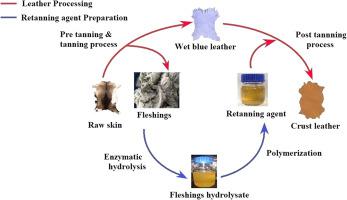Process Safety and Environmental Protection ( IF 6.9 ) Pub Date : 2021-11-04 , DOI: 10.1016/j.psep.2021.11.003 Puhazhendi Puhazhselvan 1 , Ajitha Pandi 1 , Parthasarathy Baskaran Sujiritha 1 , George Sebastian Antony 1 , Sellamuthu Nagappan Jaisankar 2 , Niraikulam Ayyadurai 1 , Palanivel Saravanan 3 , Numbi Ramudu Kamini 1

|
Discharge of huge quantities of fleshing wastes by leather industries has raised serious concerns on account of their environmental impacts. Limed fleshings, a hazardous solid waste produced from leather making process is rich in proteins and lipids. Currently, fleshing waste is not properly utilized and disposed off in unsecured manner. Utilization of fleshings for preparation of value added chemicals provide practically feasible and economically viable solution. This study investigates the feasibility of using fleshings as resource material for preparation of retanning agent by a two step process aiming at recycling of the waste. The fleshings was initially hydrolysed using Bacillus subtilis protease followed by polymerization with methacrylic acid. The performance of the resulting fleshings hydrolysate-acrylic polymer (FHAP) was assessed as retanning agent. The FHAP treated leather exhibited better fullness, grain tightness and smoothness than control leather and also improved the strength properties of the leather. SEM results revealed that the treated leather showed more cemented fiber bundles due to the efficient filling of interfibrillar space of the leather, which was confirmed by air permeability analysis. Thus, preparation of FHAP for retanning application offers sustainable solution to the problem of fleshing waste management and also an appropriate strategy for circular economy.
中文翻译:

两步法制备复鞣剂回收制革肉废料
皮革工业排放的大量去肉废物因其对环境的影响而引起了严重的关注。石灰肉是皮革制造过程中产生的危险固体废物,富含蛋白质和脂质。目前,肉质废物没有得到适当的利用和以不安全的方式处理。利用果肉制备增值化学品提供了实际可行且经济可行的解决方案。本研究调查了使用果肉作为资源材料通过旨在回收废物的两步法制备复鞣剂的可行性。果肉最初是用枯草芽孢杆菌水解的蛋白酶,然后与甲基丙烯酸聚合。所得果肉水解物-丙烯酸聚合物 (FHAP) 的性能被评估为复鞣剂。FHAP处理的皮革比对照皮革表现出更好的丰满度、粒面紧实度和光滑度,并且还改善了皮革的强度性能。SEM 结果表明,由于皮革纤维间空间的有效填充,处理过的皮革显示出更多的胶结纤维束,这通过透气性分析得到证实。因此,为复鞣应用准备 FHAP 为果肉废物管理问题提供了可持续的解决方案,也是循环经济的适当策略。











































 京公网安备 11010802027423号
京公网安备 11010802027423号